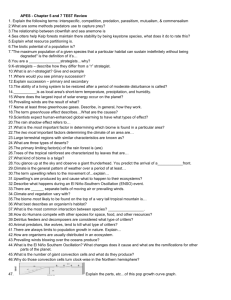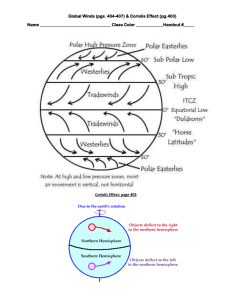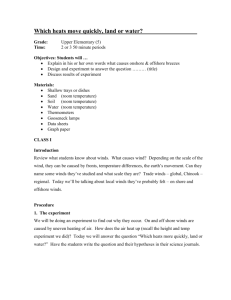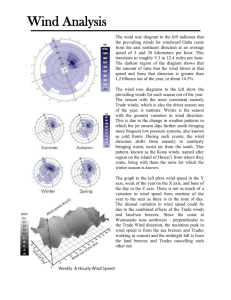Wind and Climate
advertisement
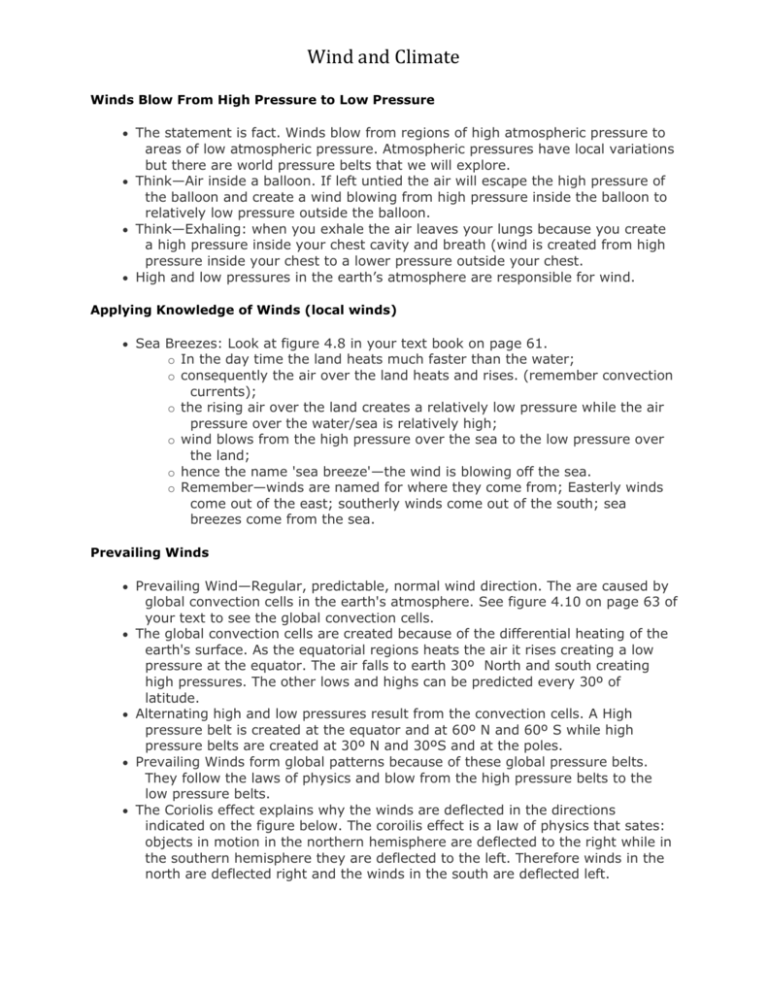
Wind and Climate Winds Blow From High Pressure to Low Pressure The statement is fact. Winds blow from regions of high atmospheric pressure to areas of low atmospheric pressure. Atmospheric pressures have local variations but there are world pressure belts that we will explore. Think—Air inside a balloon. If left untied the air will escape the high pressure of the balloon and create a wind blowing from high pressure inside the balloon to relatively low pressure outside the balloon. Think—Exhaling: when you exhale the air leaves your lungs because you create a high pressure inside your chest cavity and breath (wind is created from high pressure inside your chest to a lower pressure outside your chest. High and low pressures in the earth’s atmosphere are responsible for wind. Applying Knowledge of Winds (local winds) Sea Breezes: Look at figure 4.8 in your text book on page 61. o In the day time the land heats much faster than the water; o consequently the air over the land heats and rises. (remember convection o o o o currents); the rising air over the land creates a relatively low pressure while the air pressure over the water/sea is relatively high; wind blows from the high pressure over the sea to the low pressure over the land; hence the name 'sea breeze'—the wind is blowing off the sea. Remember—winds are named for where they come from; Easterly winds come out of the east; southerly winds come out of the south; sea breezes come from the sea. Prevailing Winds Prevailing Wind—Regular, predictable, normal wind direction. The are caused by global convection cells in the earth's atmosphere. See figure 4.10 on page 63 of your text to see the global convection cells. The global convection cells are created because of the differential heating of the earth's surface. As the equatorial regions heats the air it rises creating a low pressure at the equator. The air falls to earth 30º North and south creating high pressures. The other lows and highs can be predicted every 30º of latitude. Alternating high and low pressures result from the convection cells. A High pressure belt is created at the equator and at 60º N and 60º S while high pressure belts are created at 30º N and 30ºS and at the poles. Prevailing Winds form global patterns because of these global pressure belts. They follow the laws of physics and blow from the high pressure belts to the low pressure belts. The Coriolis effect explains why the winds are deflected in the directions indicated on the figure below. The coroilis effect is a law of physics that sates: objects in motion in the northern hemisphere are deflected to the right while in the southern hemisphere they are deflected to the left. Therefore winds in the north are deflected right and the winds in the south are deflected left. Wind and Climate Prevailing Wind Names 0-30º N = Northeast trade winds 0-30º S = Southeast trade winds 30-60º N and 30-60º S = Westerly winds 60-90º N = North Polar easterlies 60-90º N = South Polar easterlies Activity Assigned Readings p. 59-65 Assigned Activities Analyze figure 4.8b on page 61 0f your text. Predict which way the wind will blow and explain why it will blow in that direction. Test Yourself 1.What causes wind to blow? 2.What causes winds to be deflected from a straight path? 3.What causes the development of global convection cells and pressure belts? 4.Winds that normally blow in a region are referred to as _?_. 5.When do sea breezes occur? 6.What name is given to the prevailing winds between 60 and 90 degrees N? 7.What name is given to the prevailing winds between 60 and 90 degrees S? 8.What name is given to the prevailing winds between 30 and 60 degrees N? 9.What name is given to the prevailing winds between 60 and 90 degrees S? 10. What name is given to the prevailing winds between 0 and 30 degrees N? 11. What name is given to the prevailing winds between 0 and 30 degrees S? 12. When hot air rises what type of pressure is created?



